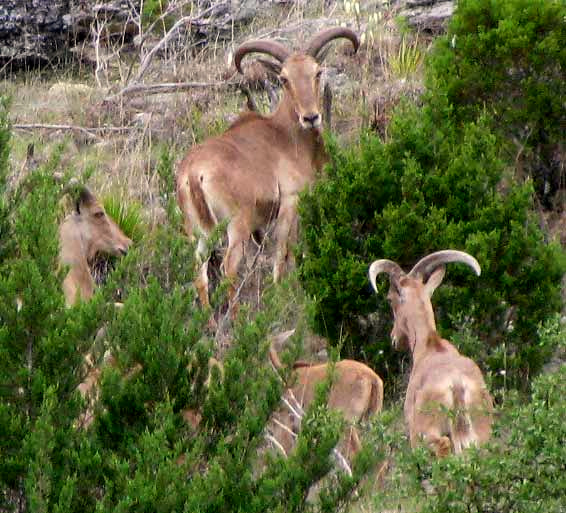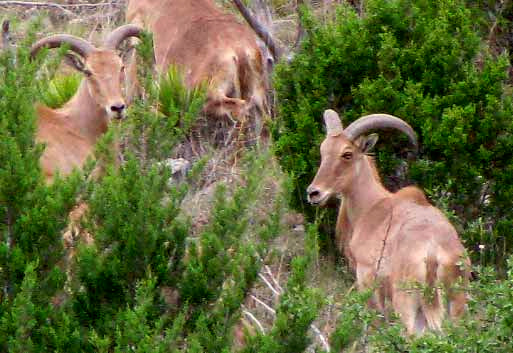Excerpts from Jim Conrad's
Naturalist Newsletter

from the May 25, 2014 Newsletter issued from the Frio Canyon Nature Education Center in the valley of the Dry Frio River in northern Uvalde County, southwestern Texas, on the southern border of the Edwards Plateau; elevation ~1750m (~5750 ft); N29.62°, W99.86°; USA
AOUDAD SHEEP
Biking down the one-lane gravel road in the upper Dry Frio Valley at first I figured that the seven or eight deer-size, sandy-brown critters on the road up ahead were just the usual white-tails or Axis Deer. However, when they began scrambling up the slope beside them they didn't move like deer. Remembering that here several big landowners who sell hunting rights to their ranches stock exotic species -- you might recall the Nubian Ibex spotted in my neighbor's goat pen last year -- I skid to a halt, retrieved the camera and snapped the picture at the top of this page.
Seeing the horns, my first impression was that they were Bighorn Sheep too young to produce that species' massive horns. Our picture even compared well enough with images of juvenile Bighorn Sheep on the Internet. However, I couldn't find reference to Bighorns being stocked in Texas, except in the Big Bend area well west of here. At that point I began browsing pictures of animals advertised on websites of local "game ranches."
They're Aoudad Sheep, also called Barbary Sheep and other names, AMMOTRAGUS LERVIA, native to rocky mountains in northern Africa, where the species is rare. However, Aoudads have been introduced to North America, southern Europe, and elsewhere, mostly by game ranches who invite hunters to shoot them.
If these Aoudads had been facing us instead of running away, it would have been easy to distinguish them from young Bighorn Sheep because Aoudads have shaggy hair on the throat that, on males, extends down to the chest, while Bighorns don't. Returning to other pictures I'd taken that morning, one shot showed a male turning around to look at me, just barely showing a shag dangling from his chest. Look at the one in the lower, right corner of the picture below:

Aoudad Sheep tails are also are much longer than those of Bighorn Sheep.
One hunting lodge offers a package "Trophy Aoudad Sheep Hunt" for $3750, and that price is in addition to $250 per day for the "All-Inclusive Hunt Package." The same lodge offers similar hunting packages for Addax, Axis Deer, Blackbuck Antelope, Buffalo, Fallow Deer -- and that only gets us to F on their list. One wonders what the long-term effect will be on the ecology when such introduced species escape into the landscape here.
Aoudad Sheep belong to the Bovid Family of mammals, the Bovidae. Bovids are cloven-hoofed (hoof split into two toes), are ruminants (usually cud-chewing), and bear non-branching horns. Within the Bovid Family, Aoudads belong to the Subfamily Caprinae, often known as goat-antelopes. This brings up the question of "What's the difference between goats, sheep and antelopes?
The easiest way to tell the difference between a sheep and goat is to look at their tails. A goat's tail goes up, unless it's sick or upset, while sheep tails hang down. Antelopes are harder to define, the term being used for species that are neither cattle, sheep, water buffalo, bison, nor goats. By the way, antelopes don't shed their horns, but deer do.